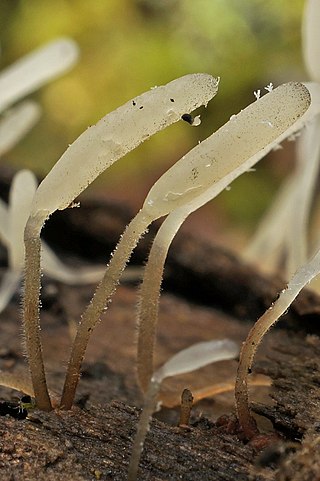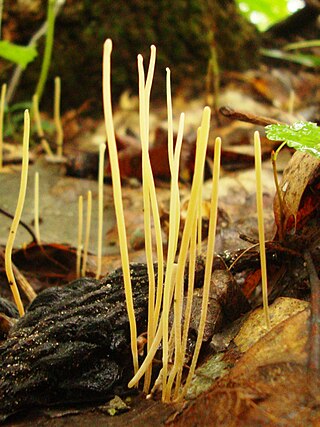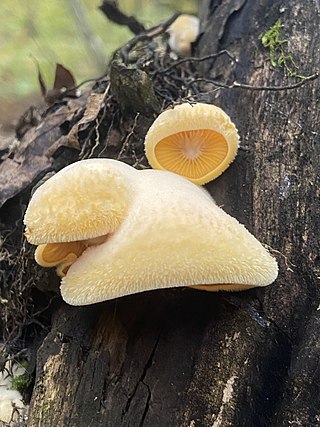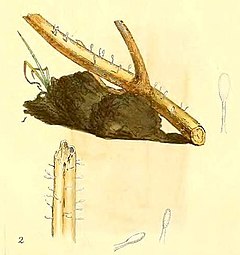
The Clavariaceae are a family of fungi in the order Agaricales. Originally the family contained most of the clavarioid fungi, but in its current sense is more restricted, albeit with a greater diversity of basidiocarp forms. Basidiocarps are variously clavarioid or agaricoid (mushroom-shaped), less commonly corticioid or hydnoid.

Rhizoctonia solani is a species of fungus in the order Cantharellales. Basidiocarps are thin, effused, and web-like, but the fungus is more typically encountered in its anamorphic state, as hyphae and sclerotia. The name Rhizoctonia solani is currently applied to a complex of related species that await further research. In its wide sense, Rhizoctonia solani is a facultative plant pathogen with a wide host range and worldwide distribution. It causes various plant diseases such as root rot, damping off, and wire stem. It can also form mycorrhizal associations with orchids.

Helicobasidium purpureum is a species of fungus in the subdivision Pucciniomycotina. Basidiocarps are corticioid (patch-forming) and are typically violet to purple. Microscopically they have auricularioid basidia. Helicobasidium purpureum is an opportunistic plant pathogen and is one of the causes of violet root rot of crops and other plants. DNA sequencing suggests that it is a complex of more than one species. The species has a conidia-bearing anamorph in the Tuberculina persicina complex that is a parasite of rust fungi.

Typhula incarnata is a fungal plant pathogen in the family Typhulaceae.
Typhula ishikariensis is, along with Typhula incarnata, the causal agent of grey snow mould, an obligately parasitic plant pathogen that can destroy turfgrass when covered for a long period with snow. It is a particular problem on golf courses established in unsuitable areas. More importantly, it can also damage crops of winter wheat. The species was described as new to science in 1930 by Japanese mycologist Sanshi Imai. The varieties canadensis and ishikariensis were described in 1978. There is a wide variety within the species and not all authorities agree as to subspecies, or even whether it should be monophyletic.

Ceratobasidium cornigerum is a species of fungus in the order Cantharellales. Basidiocarps are thin, spread on the substrate out like a film (effused) and web-like. An anamorphic state is frequently obtained when isolates are cultured. Ceratobasidium cornigerum is saprotrophic, but is also a facultative plant pathogen, causing a number of economically important crop diseases, and an orchid endomycorrhizal associate. The species is genetically diverse and is sometimes treated as a complex of closely related taxa. DNA research shows the species actually belongs within the genus Rhizoctonia.
Ceratellopsis is a genus of fungi in the family Clavariaceae. Basidiocarps grow gregariously on fallen wood, bark, and decaying plant material and are clavarioid, simple, small, with an acute apex. Only two species are currently recognized; other species formerly placed in Ceratellopsis have been transferred to other genera or are nomina dubia.

The Typhulaceae are a family of clavarioid fungi in the order Agaricales. Basidiocarps are small, simple, and typically club-shaped with a distinct stem. The family originally contained several genera, including Macrotyphula and Ceratellopsis, but molecular research, based on cladistic analysis of DNA sequences, has shown that only the type genus Typhula belongs in the Typhulaceae, the other genera being synonyms or belonging to other families. The monotypic Lutypha sclerotiophila has not yet been sequenced.

Clavaria is a genus of fungi in the family Clavariaceae. Species of Clavaria produce basidiocarps that are either cylindrical to club-shaped or branched and coral-like. They are often grouped with similar-looking species from other genera, when they are collectively known as the clavarioid fungi. All Clavaria species are terrestrial and most are believed to be saprotrophic. In Europe, they are typical of old, mossy, unimproved grassland. In North America and elsewhere, they are more commonly found in woodlands.

The clavarioid fungi are a group of fungi in the Basidiomycota typically having erect, simple or branched basidiocarps that are formed on the ground, on decaying vegetation, or on dead wood. They are colloquially called club fungi and coral fungi.

The cyphelloid fungi are a polyphyletic group of fungi in the Basidiomycota that have disc-, tube-, or cup-shaped basidiocarps, resembling species of discomycetes in the Ascomycota. They were originally referred to the genus Cyphella and subsequently to the family Cyphellaceae, but are now known to be much more diverse and are spread through several different genera and families. Since they are often studied as a group, it is convenient to call them by the informal (non-taxonomic) name of "cyphelloid fungi". Better known cyphelloid genera include Calyptella, with stalked, cup- or bell-like fruit bodies; Lachnella, with conspicuous, hairy-margined, disc-like fruit bodies; Flagelloscypha with smaller, but equally hairy, cup-like fruit bodies; Henningsomyces with tube-like fruit bodies; and Merismodes with clustered, hairy, cup-like fruit bodies.

Macrotyphula is a genus of clavarioid fungi in the family Phyllotopsidaceae. Basidiocarps are simple, narrowly club-shaped to filiform, sometimes arising from a sclerotium. They typically grow on dead wood or leaf litter, often in swarms.

Clavaria fragilis, commonly known as fairy fingers, white worm coral, or white spindles, is a species of fungus in the family Clavariaceae. It is synonymous with Clavaria vermicularis. The fungus is the type species of the genus Clavaria and is a typical member of the clavarioid or club fungi. It produces tubular, unbranched, white basidiocarps that typically grow in clusters. The fruit bodies can reach dimensions of 15 cm (6 in) tall by 0.5 cm thick. There are several similar coral-like fungi.

Ceratobasidium is a genus of fungi in the order Cantharellales. Basidiocarps are effused and the genus is sometimes grouped among the corticioid fungi, though species also retain features of the heterobasidiomycetes. Anamorphic forms were formerly referred to the genus Ceratorhiza, but this is now considered a synonym of Rhizoctonia. Ceratobasidium species, excluding the type, are also now considered synonymous with Rhizoctonia and some species have been transferred to the latter genus. Species are saprotrophic, but several are also facultative plant pathogens, causing a number of commercially important crop diseases. Some are also endomycorrhizal associates of orchids.

Rhizoctonia is a genus of fungi in the family Ceratobasidiaceae. Species form thin, effused, corticioid basidiocarps, but are most frequently found in their sterile, anamorphic state. Rhizoctonia species are saprotrophic, but some are also facultative plant pathogens, causing commercially important crop diseases. Some are also endomycorrhizal associates of orchids. The genus name was formerly used to accommodate many superficially similar, but unrelated fungi.

Typhula quisquiliaris, commonly known as the bracken club, is a species of club fungus in the family Typhulaceae. It produces small, white fruit bodies up to 9 millimetres (0.4 in) in height, each with a single distinct "head" and "stem". The head is fertile, while the stem attaches to a sclerotium embedded in the substrate. The fruit bodies grow from dead wood, and strongly favours bracken, where the species feeds saprotrophically. Though T. quisquiliaris was described under a different name by James Sowerby in 1803, the specific name quisquiliaris was sanctioned in 1821 by Elias Magnus Fries, and the species was moved to the genus Typhula, which resulted in its currently accepted binomial name by Paul Christoph Hennings in 1896. The species has been recorded in Europe and north Africa.
Typhula blight is most commonly known as a turf disease, but can also be a problem with wheat. Typhula blight is caused by a Typhula fungus, either Typhula incarnata or T. ishikariensis. Typhula incarnata is the causal agent for gray snow mold and T. ishikariensis causes speckled snow mold. Snow molds are caused by cold tolerant fungi that require snow cover or prolonged periods of cold, wet conditions. Typhula blight is most notably found in the turf industry, affecting a wide range of turfgrasses. Upon the snow melt, gray circular patches of mycelium are found. These mycelia produce a survival structure called a sclerotia that survives the warm summer months. Typhula blight is commonly controlled with fungicide applications in the late fall and by other cultural practices. If unchecked, snow molds can cause severe turf loss.
Snow mold is a type of fungus and a turf disease that damages or kills grass after snow melts, typically in late winter. Its damage is usually concentrated in circles three to twelve inches in diameter, although yards may have many of these circles, sometimes to the point at which it becomes hard to differentiate between different circles. Snow mold comes in two varieties: pink or gray. While it can affect all types of grasses, Kentucky bluegrass and fescue lawns are least affected by snow mold.

The Phyllotopsidaceae are a family of fungi in the order Agaricales. Basidiocarps are either clavarioid (Macrotyphula), agaricoid (Tricholomopsis), or cyphelloid. Marcel Locquin originally established the family on the basis of shared morphological characteristics, but did not validly publish it. The name was later validated by Olariaga and the family was expanded to contain other genera as a result of molecular research, based on cladistic analysis of DNA sequences.
Pterulicium gracile is a species of mushroom producing fungus in the family Pterulaceae.













